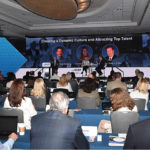
Australia is a convenient hub for the entire Asia-Pacific region, and the high-tech, six-year-old convention center, already poised for a major expansion, is an ideal venue to host a major exhibition.
I arrived in Melbourne a day early to attend a press conference that kicked off Australia’s third annual Business Events Week. Matt Hingerty, chairman of the Business Events Council of Australia (BECA), gave an overview of a just-published economic impact study of the country’s meetings and events industry — the first such study conducted in more than a decade. Among other findings, BECA’s research showed that the 2,157 major exhibitions held in Australia in 2014 attracted more than 65,000 exhibitors and 9.3 million visitors.
AIME undoubtedly will hold its own when BECA pulls together statistics for 2015. More than 11,000 meetings took place between the show’s 700 exhibitors and nearly 500 hosted buyers. Forty percent of the planners attending the show were there for the first time. Karen Bolinger, the MCB’s CEO, explained that new AIME attendees are recruited by panels in each of their home destinations. As a first-time visitor myself, I was impressed by the sheer number of destinations, products, and services represented on the show floor and the level of enthusiasm among attendees.
Because AIME is built around three pillars — education, networking, and business — hosted-buyer appointments are only a third of the story. The education program featured keynote addresses, seminars, and panels held in MCEC’s auditoriums throughout the two-day event. Topics included everything from securing sponsorship for events to hybrid meetings to personal creativity.
The Community Hub, a large, open area at the center of the show floor, was designed to facilitate networking and maximize engagement. Attendees could sit down for impromptu face-to-face chats, sample canapés whipped up in MCEC’s kitchens, or fill up a bag of mix-and-match candy. A section of the Hub was set aside for “silent seminars,” a series of short video presentations on business and leadership shown on a projection screen, with headsets available for the audience. Attendees could even sign up for a 15-minute session with a career coach.
The Hub was a key aspect of reimagining the show, according to Bolinger. She explained that the MCEC/MCB team and Reed Travel looked at last year’s post-event surveys to find areas that needed to be rethought. One clear priority that emerged was engagement. “We want to keep people engaged in a 24/7/365 world,” Bolinger said. “Why just meet once a year?” To this end, the Hub was designed to catch eye traffic and create a focal point on the show floor, encouraging attendees to chat with each other between appointments. She also said that silent disco dance parties, where revelers pop on headphones and dance to the music of their choice, were the inspiration for the Hub’s silent seminars.
In years past, AIME has commenced with a welcome breakfast. This year, the exhibition team decided to break with tradition and host a sit-down gala dinner after the close of the show. The event was held at Central Pier in Melbourne’s trendy Docklands neighborhood. Tables were set up in a converted parking lot overlooking Victoria Harbour, and a formal, three-course, plated meal was followed by a lighthearted dessert. Much to the amusement of the smartly dressed guests, servers passed around soft-serve ice-cream cones — and those who wanted seconds could wait in line at an ice-cream truck parked dockside.
It was a fitting conclusion to an event that successfully combined the serious business of booking major events in destinations throughout Asia and the Pacific Rim with the opportunity to network over a cup of jellybeans or some tomato-mozzarella macaroons in the Hub.



